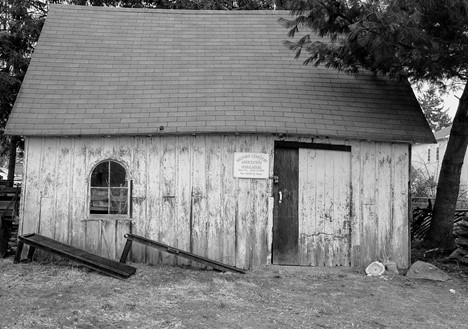By Marilyn May
Milford History

This hearse house built in 1825 is in the Milford Cemetery. Small buildings where hearses were stored were once very common across New England. They are disappearing with the passage of time and no one knows for sure how many remain. Photo courtesy of Marilyn May.
The Milford Cemetery is the oldest burial ground in the United States still doing interments.
The history of Milford’s burial grounds reveals a lot about the history of the settlement. In 1639, about 200 Puritan settlers from England, and some from Wethersfield, followed the Rev. Peter Prudden into territory largely unknown to them to establish their own independent colony. Originally, the people were governed by the scriptures in the Bible.
The settlement took root, but in the earliest years life was hard and lifespans were short – especially for children. In 1644, the first English person to die in Milford was 1-year-old Solomon East, son of William East. The first deceased adult was Sarah Camp, wife of Nicholas Camp, who in 1645 succumbed a few days after giving birth to twins.
And so began the long line of settlers to enter the state of eternal rest. The earliest interments were in the garden of Rev. Prudden’s home lot on East Town Street, now called Prospect Street. Settlers chose to be buried near their beloved pastor and leader.
The custom of the Puritans was to bury people quickly and not in family plots as was done later, but side by side as they died. The deceased were buried in shrouds without caskets. The earliest graves were not marked, because Puritans thought that would be a show of vanity; besides, the soul of the deceased had ascended to heaven. The thought was that there was no need to mark the spot of earthly remains.
Prudden died in 1656 at the age of 56 and was buried in his garden alongside his faithful flock. According to Benjamin Trumbull’s 1797 book, “The Complete History of Connecticut,” Prudden was traveling home from Derby and was found dead in a stream. Trumbull wrote, “It was supposed that he fell from his horse in a fit.”
It wasn’t until 1675 that a formal burying ground was laid out on property that was adjacent to the garden burial ground and was probably part of Prudden’s seven-acre property. The many open spaces in the oldest part of the cemetery’s southwest corner along the railroad tracks today most certainly were other gravesites, but there are no records about that. The earliest of all gravestones that can be read is that of a William Roberts (1617-1689). As often happened, the stone carver was not a great speller and the small stone actually reads Robarts.
Early markers were about three feet high and made of local slate, sandstone or limestone. Sandstone was particularly prone to cracking and flaking, making the wording illegible.
Marble and granite were used later on along with more slate, because slate weathered well and was easy to carve. As time went on, the markers were taller and had wording that served as a warning, as if the deceased was talking to the living.
Behold & see, as you pass by
as you are now so once was I.
As I am now, so you must be.
Prepare for death & follow me.
These sentiments expressed the transitory nature of life.
From 1720 to 1780, grim symbols of skulls with wings called death heads gave a warning of what was to come. Eventually, the skull symbols with gritted teeth became less gruesome and the style changed to using more like human-like faces. Another cautionary symbol was a winged heaven-bound sand timepiece showing earthly time running out. To the Puritans, salvation was not a certainty; the message was to use your time now to lead more faithful lives.
Art historians at one time thought that the Puritans’ starkly unadorned homes and worship spaces revealed no trace of cultural artwork. That was until they realized the gravestone sculptures were among the earliest forms of American art. Better still, the works were dated and a few had the names of the sculptors.
Those warnings on earlier gravestones gradually gave way to more celebratory markings, indicating a change in thought about death.
Winged cherubim slowly started showing up in carvings around 1760 and remained popular until about 1800. The cherubim represented a positive sign of things to come. Cherubs are the second highest order of spirit figures and are said to be the ones who surround and protect the sides of the throne of God. (Seraphim are the highest order and are said to hover over and protect God from above.)
Then starting in 1770, and especially from 1790 to 1820, urn and willow symbols came into use, focusing more on the living. The willow tree represented mourning and the empty urn signified the death and immortality of a risen loved one.
Milford purchased a $70 horse-drawn hearse in 1825, replacing the earlier practice of transporting the deceased on a bier. The hearse was stored on the cemetery property in what was called a hearse house. Milford’s still stands near the cemetery office just off Gulf Street.
For more than 200 years Milford Cemetery was owned by the town and supported by tax dollars. Often the town’s herds of sheep were allowed onto the grounds to munch down the grass and weeds.
The Milford Cemetery Association was created in 1901 by an act of the state legislature to take ownership, pay costs, supervise burials and care for the grounds. In 2014, a now 30-member Friends of the Milford Cemetery organization was formed to clean, straighten and repair the tombstones.
Marilyn May is a lifelong resident of Milford and is on the board of the Milford Historical Society.